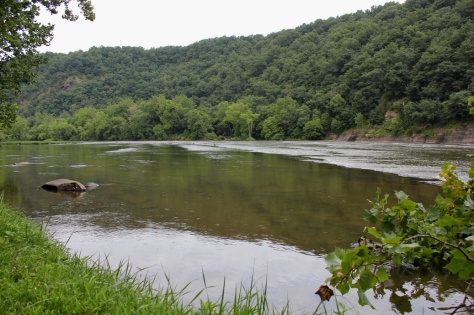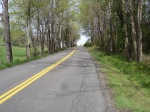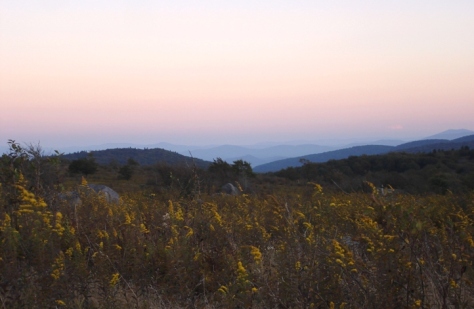Big Walker Mountain is one of the most prominent mountains in Southwestern Virginia’s valley and ridge province. From its rise as mere hill in Washington County (see my description of it in the Saltville Loop article), Big Walker rises to 3500’ above sea level, and all the way from Saltville to the New River beyond Pulaski it is the main dividing ridge between the great valley that contains Route 11 and Interstate 81 and the valleys to the north. In fact, it is so prominent and without any significant gap that the engineers who built I-77 created a tunnel to go through it.
The Southwest Virginia Cyclists use the primary and secondary highways that cross Big Walker Mountain for many of their training climbs. They also sponsor two organized rides over the mountain each year, the Mother of a Metric and the Big Walker Mountain Century Ride.
The Ride
 This past weekend, Saturday, June 18, 2011, was the 8th Big Walker Century Ride. The Big Walker Century has four ride options, including a metric century (100 kilometers) and an English century (100 miles). This was the second year I did the metric century with a buddy from Abingdon. There were about 100 riders who toed the start line in the morning.
This past weekend, Saturday, June 18, 2011, was the 8th Big Walker Century Ride. The Big Walker Century has four ride options, including a metric century (100 kilometers) and an English century (100 miles). This was the second year I did the metric century with a buddy from Abingdon. There were about 100 riders who toed the start line in the morning.
The conditions turned out to be good for a long distance ride. The morning started out cloudy, a bit chilly, and threatening rain. As the ride progressed the skies cleared somewhat, and we had partly sunny weather for the tail end of the ride. The ride starts and finishes in Wytheville. The beginning of the ride this year began with a typical peloton mass start in downtown Wytheville at 7:30 AM. There was a police escort for at least the first 15 miles. This ride usually starts out at a pretty hard pace. The local pack of Southwest Virginia Cyclists leads the peloton, and they are usually hammering pretty hard following the police car. This year there were about 100 cyclists in the peloton.
This year involved an inauspicious start as I was cut off in the peloton by an errant rider within the first five miles. I was driven off the pavement. Like the famous decision of Lance Armstrong to take a short cut in stage 9 of the Tour de France in 2003 in order to avoid the crash with Joseba Beloki, or the quick decision of many professional riders to go off the pavé in Paris Roubaix to avoid crashes, I had to make a split second decision to avoid a crash and went off Route 11 at 30 mph. I drove into the gravel shoulder and feathered my brakes to slow, standing on the pedals and leaning back so as not to endo.
While I was fortunate the incident occurred where there was a shoulder that allowed me to decelerate without flipping or crashing, I was unfortunate in that it occurred on a stretch of road just before the beginning of a long hill. With adrenaline pumping and my heart pounding, I came to a stop, looked up, and saw the back peloton receding towards the distant top of the hill. Having lost contact with the peloton and with no forward momentum, I then realized I would have no draft for next 15 or so miles to the base of the climb; the lead pack was gone, not be seen again for the rest of the ride. I eventually caught up with my buddy James, and we rode the rest of the ride more or less together.
The Climbs
The climb up Big Walker Mountain on Rt. 52 is a moderately difficult climb of 1000 vertical feet at a 5% gradient (from 2400’ to 3400’). The climb takes 30-45 minutes. The gradient is consistent—there are no very sharp spikes in the gradient, thus allowing a cyclist to get into a good rhythm.
Coming from Wytheville, when you reach the top of the mountain on the metric century ride you go left (west) down Old Mountain Road, aka County Road 621, which is a narrow single lane road with great views down the valley. County Road 621 actually resembles many of the mountain roads in Europe with its solid white lines on both sides and proximity to the side of the mountain, sometimes without any guard rail to prevent going off the side. (Last year the organized ride went right at the top of the mountain continued down Route 52.)
The most scenic part of the ride is definitely on the north side of the mountain in Rich Valley. The valley is fairly narrow with mountain scenery on both sides.
The climb up the backside (north side) of the mountain on Route 52 is about 700 vertical feet at a 5.2% gradient (from 2700’ to 3400’). The gradient on this climb is also consistent. This is just a bit steeper climb with tighter switchbacks than the climb up the south side.
We finished the ride in 3 hours, fifty minutes at an average speed of 16.4 mph. We also spent about 20 minutes out on the course stopped at aid stations; they were well-stocked and had lots of goodies for re-fueling.
Training on Big Walker
I have done the Big Walker Mountain climb many times on my own without any organized ride. This is one of the best training rides in Southwest Virginia. Route 52 has a good, steady gradient and is generally wide for a mountain road in this region. The climb is similar to the climb over Route 421 near South Holston Lake in Bristol, Tennessee.
One way to approach this climb without riding on Route 11 (the busiest stretch of the organized century ride) is to start in Rural Retreat, Virginia (Rural Retreat is ½ mile to the south of Exit 60 on I-81). Park in one of the municipal parking areas or church parking lots in downtown Rural Retreat.
From your starting location, take Main Street north back towards the Interstate. You ride under the I-81 at Exit 60 and will be on Black Lick Road, aka County Road 680. Continue north on Black Lick Road. Black Lick Road eventually junctions with Route 52. Make a left on Route 52 and you will approach the Big Walker Climb. Once you reach the top of the mountain you can go down the backside, or simply return back to Rural Retreat. From this point you can follow the directions from the cue sheet from the organized ride, which is set forth below.
At the top of the mountain there is the Big Walker Country Store. This is good place to refuel. There is also a lookout on the north side of the mountain and some scenic vistas from the store itself.
Cue Sheet for Big Walker Mountain Metric Century Ride
Start Head southwest on S Main St toward N 4th St
0.43mi Turn right onto N 12th St
0.43mi Head northwest on US-11 S/N 12th St toward W Monroe St Continue to follow US-11 S
1.1mi Slight left onto US-11 N/W Lee Hwy
13.19mi Turn right onto Kimberlin Rd/State Route 682
13.2mi Head north on Kimberlin Rd/State Route 682 toward Mt Airy Rd/State Route F-015
14.2mi Head northeast on Kimberlin Rd/State Route 682 toward Ridge Top Dr
Continue to follow Kimberlin Rd
16.41mi Turn left onto Blacklick Rd/State Route 680
16.42mi Head north on Blacklick Rd/State Route 680
18.53mi Turn left to stay on Blacklick Rd/State Route 680
19.18mi Turn left to stay on Blacklick Rd/State Route 680
Continue to follow State Route 680
23.51mi Turn left onto U.S. 52 N/Stony Fork Rd (Note this is the junction I describe in the alternative trip from Rural Retreat)
23.52mi Head northwest on U.S. 52 N/Stony Fork Rd
Continue to follow U.S. 52 N
30.81mi Head southeast on U.S. 52 S/S Scenic Hwy W toward Old Mountain Rd/State Route 621
30.82mi Turn left onto Old Mountain Rd/State Route 621
33.66mi Head west on Old Mountain Rd/State Route 621 toward VA-42 E/W Blue Grass Trail
33.76mi Sharp right onto VA-42 E/W Blue Grass Trail
38.69mi Head east on VA-42 E/W Blue Grass Trail toward U.S. 52 S/S Scenic Hwy
38.7mi Turn right onto U.S. 52 S/S Scenic Hwy
39.41mi Turn left onto State Route 617/Waddletown Rd
39.42mi Head west on State Route 617/Waddletown Rd toward U.S. 52 N/S Scenic Hwy
39.43mi Turn left onto U.S. 52 S/S Scenic Hwy
Continue to follow U.S. 52 S
42.87mi Head east on U.S. 52 S/Stony Fork Rd
Continue to follow U.S. 52 S (Note that if you are going back to Rural Retreat, you need to watch for Black Lick Road, aka County Road 680, after coming off of the mountain, you would make a right onto Black Lick Road and follow it back into Rural Retreat)
53.04mi Head east on N 4th St toward W Ridge Rd
53.04mi Turn right onto W Ridge Rd
53.92mi Head southeast on W Ridge Rd toward N Petunia Rd
55.97mi Turn left onto N 4th St
55.97mi Head southeast on N 4th St toward W Ridge Rd
55.98mi Turn left onto W Ridge Rd
56.09mi Head northeast on W Ridge Rd toward Tazewell St
56.1mi Turn right onto Tazewell St
56.44mi Turn right onto W Spiller St
56.44mi Head southwest on W Spiller St toward N 4th St (you are in downtown Wytheville)

































